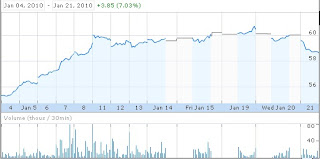Investors seeking to diversify holding into foreign markets have been flocking to global ETFs (
live tracking). However, because the US dollar nearly collapsed in 2009, a rebound may happen at any time. At that point, any holdings in foreign currency could suffer big losses. This happened in late 2009 when the US dollar rebounded a little.
So WisdomTree has just launched a currency-hedged ETF. it is actually an ETF of ETFs, investing in WisdomTree Europe Total Dividend Fund
DEB, WisdomTree Japan Total Dividend Fund,
DXJ,
WisdomTree Pacific ex-Japan Total,
DND.
One of the potential issues with ETFs is the correlation of the underlying components. In this case, here it is for Q4 2009:
Two out of 3 is not bad. DND and DEB are correlated.
In term of currencies, this the exposure:
1. EUR
| 44.85%
|
2. GBP
| 20.84%
|
3. JPY
| 12.45%
|
4. AUD
| 9.65%
|
5. CHF
| 5.49%
|
6. SEK
| 2.96%
|
7. SGD
| 2.39%
|
8. NOK
| 1.36%
|
As you can see, the Euro makes up for nearly 50%.
HEDJ is still quite illiquid, see chart below:
Its MER is 0.58%.
WisdomTree's COO Bruce Lavine said "there are more than 250 international-stock ETFs on the market, but all come with foreign-currency exposure. The dollar has fallen quite a bit, but if the economy improves some think we could see a stronger dollar,"
ETF description:
WisdomTree International Hedged Equity Fund seeks investment results that closely correspond to the price and yield performance, before fees and expenses, of the
WisdomTree DEFA International Hedged Equity Index.
The Fund employs an investment approach designed to track the performance of the WisdomTree DEFA International Hedged Equity Index. The Index and the Fund are designed to provide exposure to equity securities in Europe, Far East Asia and Australasia, while at the same time hedging exposure to fluctuations between the value of the U.S. dollar and selected non-U.S. currencies in these regions. The Index and the Fund seek to track the performance of equity securities in these developed markets that is attributable solely to stock prices without the effect of currency fluctuations.
The WisdomTree International Hedged Equity Fund operates as a “fund of funds and attempts to achieve its investment objective by investing primarily in other WisdomTree exchange traded funds . Instead of investing in several hundred securities, the Fund now invests primarily in the WisdomTree Europe Total Dividend Fund, Japan Total Dividend Fund and Pacific ex-Japan Total Dividend Fund. By investing in these ETFs the Fund will achieve exposure to the securities in the WisdomTree DEFA International Hedged Equity Index.



















































